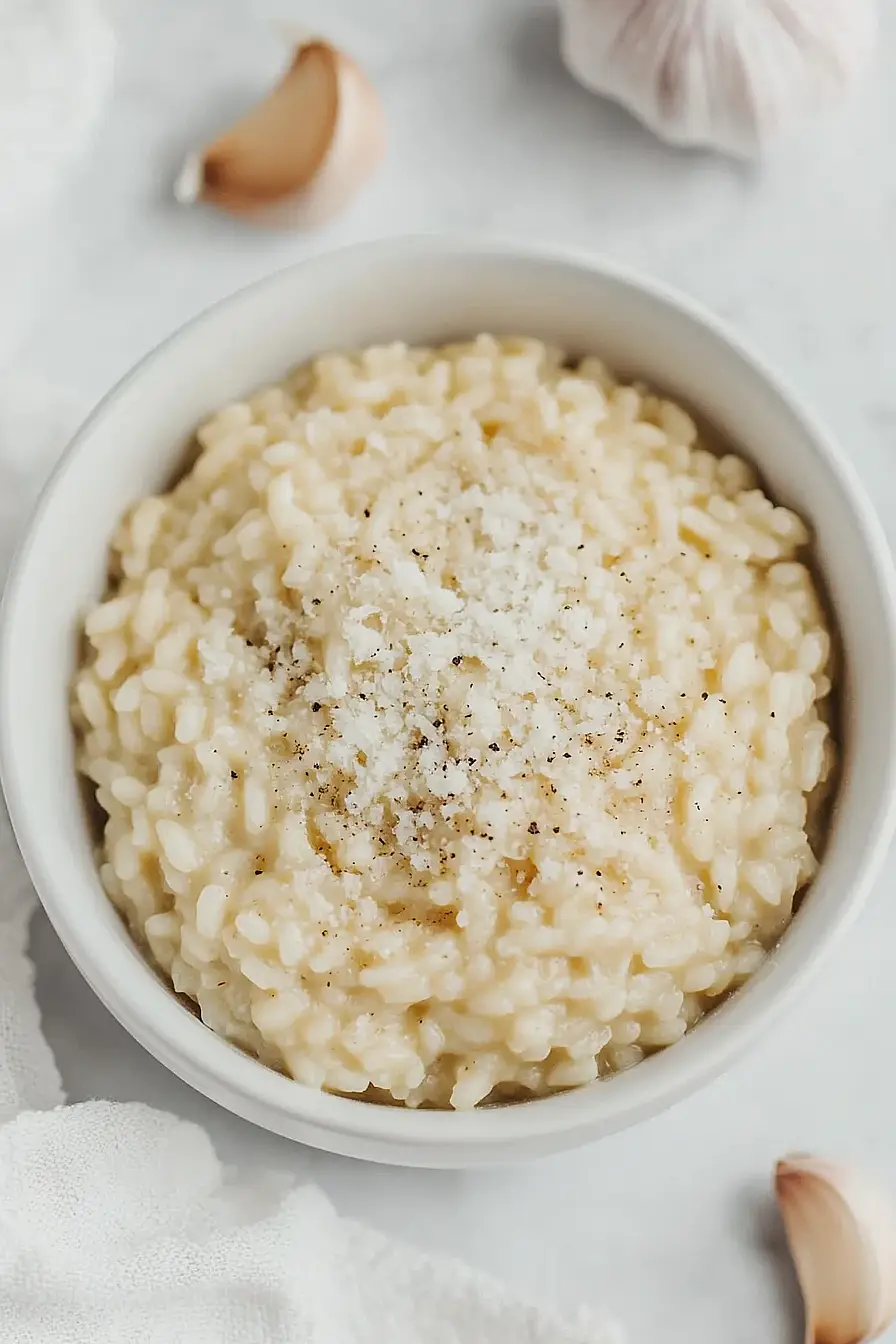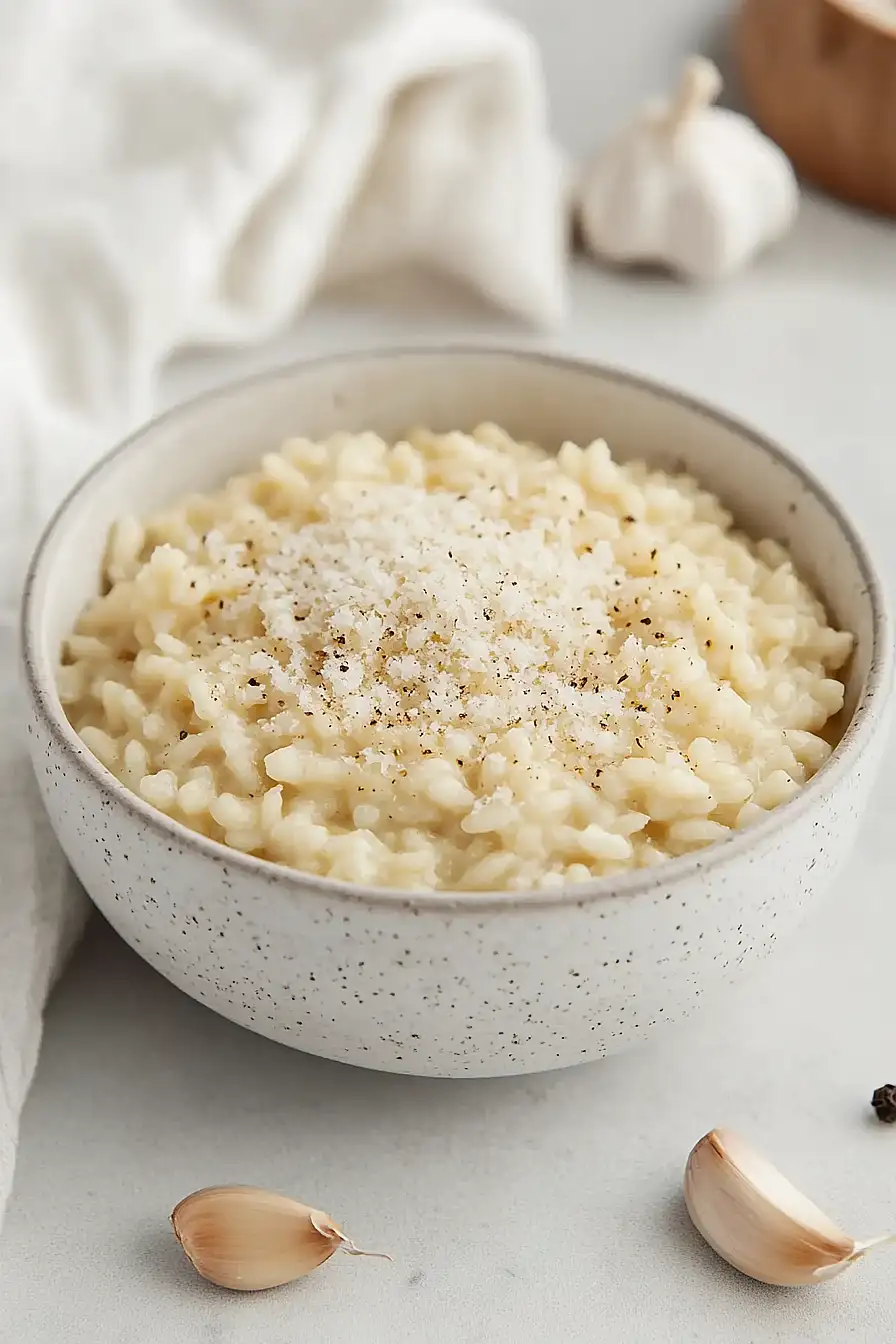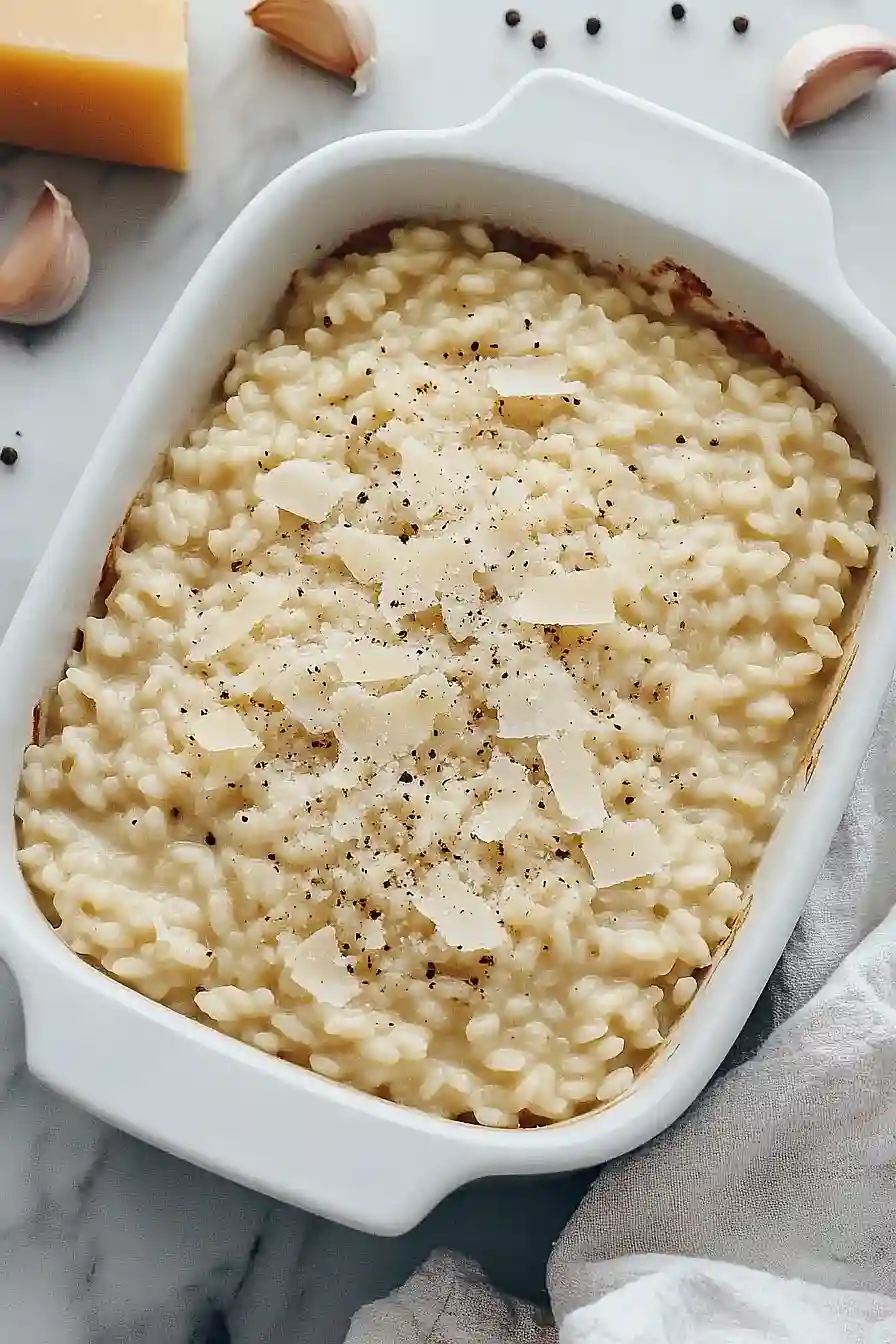If you ask me, making risotto at home is easier than most people think.
This creamy Italian rice dish is perfect for a cozy dinner for two, combining simple ingredients into something that feels special. The rice slowly absorbs warm broth while you stir, creating that classic comfort-food texture we all love.
It starts with good arborio rice and a splash of white wine, then builds flavor with each ladle of stock. A handful of Parmesan cheese at the end makes everything come together just right.
It’s a perfect date-night dish that feels fancy but won’t keep you in the kitchen all evening.

Why You’ll Love This Risotto
- Perfect portion size – This recipe is specially scaled for two people, making it ideal for date nights or small households without dealing with lots of leftovers.
- Restaurant-quality results – With simple ingredients like arborio rice, wine, and parmesan, you’ll create a creamy, luxurious risotto that tastes like it came from your favorite Italian restaurant.
- Basic ingredients – You’ll only need a handful of pantry staples and fresh items to make this classic dish – no fancy or hard-to-find ingredients required.
- Customizable base – This classic risotto recipe serves as a perfect foundation – you can easily add vegetables, mushrooms, or seafood to make it your own.
What Kind of Rice Should I Use?
When it comes to making authentic risotto, arborio rice is the classic choice, but you’ve got a few other options from the Italian rice family. Arborio is the most widely available variety, with its short, plump grains that release lots of starch while cooking to create that creamy texture we all love. If you can find them, Carnaroli or Vialone Nano rice are excellent alternatives – some chefs actually prefer Carnaroli because it’s a bit more forgiving and harder to overcook. Just don’t try to substitute regular long-grain rice or other varieties, as they won’t give you that signature creamy risotto texture. Make sure to never rinse your risotto rice before cooking, as you want to keep all that valuable starch that makes risotto, well, risotto.

Options for Substitutions
While risotto has some must-have ingredients, there’s still room for some swaps:
- Arborio rice: This is one ingredient you really shouldn’t substitute – it’s essential for that creamy risotto texture. Other rice types won’t release the same starches needed for true risotto.
- White wine: If you prefer not to use wine, you can replace it with an equal amount of stock plus 1 tablespoon of lemon juice to add that slight tang.
- Parmesan cheese: For best results, stick with Parmesan, but Pecorino Romano or Grana Padano can work too. Just avoid pre-grated cheese as it won’t melt as smoothly.
- Stock: Both chicken and vegetable stock work great. In a pinch, you can use water with bouillon cubes, but the flavor won’t be quite as rich.
- Butter: You can use all olive oil instead of butter, though you’ll miss out on some richness. For dairy-free options, a good quality vegan butter can work.
- Yellow onion: Feel free to swap with shallots for a slightly milder flavor, or even leeks (white part only) if you have those on hand.
Watch Out for These Mistakes While Cooking
The biggest mistake when making risotto is rushing the process – adding too much stock at once will give you a gummy texture instead of the creamy, velvety consistency you’re after, so add the warm stock gradually, about 1/2 cup at a time, stirring until each addition is absorbed. Another common error is not keeping your stock hot while cooking – cold stock will interrupt the cooking process and lead to uneven rice texture, so keep it simmering in a separate pot throughout the cooking process. Your risotto needs constant attention and stirring to release the starches from the rice, but be careful not to stir too vigorously or you’ll end up with a gluey mess – use gentle, consistent stirring motions instead. For the best results, serve your risotto immediately while it’s still loose and creamy (it will continue to thicken as it sits), and don’t skip the final addition of butter and cheese, which gives the dish its signature silky finish.

What to Serve With Risotto?
This creamy Italian rice dish is super filling on its own, but it really shines when paired with a few simple sides. A light green salad with lemon vinaigrette helps balance out the richness of the risotto, while some roasted asparagus or sautéed mushrooms make perfect vegetable companions. If you’re craving protein, try serving it with pan-seared scallops or grilled chicken breast – both options work great with the parmesan and wine flavors in the risotto. For a truly Italian experience, serve some crusty bread on the side to soak up any extra creamy sauce left on your plate.
Storage Instructions
Keep Fresh: Got leftover risotto? Pop it in an airtight container and keep it in the fridge for up to 3 days. Just know that risotto is really at its best when it’s fresh and creamy, right off the stove. The texture will get a bit firmer in the fridge, but it’s still totally good to eat!
Make Ahead: While risotto is best made fresh, you can prep some ingredients ahead of time. Chop your onions and garlic, and measure out your rice and cheese. Keep your stock warm on the stove when you’re ready to start cooking – this helps the rice cook evenly and creates that perfect creamy texture.
Warm Up: To bring leftover risotto back to life, warm it up in a pan over medium-low heat. Add a splash of warm stock or water while stirring to help restore that creamy consistency. You might want to add an extra pat of butter and a sprinkle of fresh parmesan to make it extra yummy again.
| Preparation Time | 10-15 minutes |
| Cooking Time | 35-45 minutes |
| Total Time | 45-60 minutes |
| Level of Difficulty | Medium |
Estimated Nutrition
Estimated nutrition for the whole recipe (without optional ingredients):
- Calories: 600-700
- Protein: 20-25 g
- Fat: 30-35 g
- Carbohydrates: 70-80 g
We'll Pay You $5 to Try This Recipe!
Cook our recipe, snap some photos, and earn a $5 Amazon Gift Card. It's that simple!
Here's how:
- Make the recipe
- Take nice pictures of your final dish
- Fill out our quick form (2 minutes max!)
- Your $5 reward is on the way!
Ingredients
- 2 1/2 cups quality chicken or vegetable broth
- 1 tbsp olive oil
- 2 tbsp unsalted butter, divided
- 1/3 cup minced yellow onion
- Pinch kosher salt
- 1 garlic clove, finely minced
- 1/4 cup dry white wine
- 1/2 cup uncooked arborio rice
- 1/2 cup freshly grated parmesan
- 1 lemon wedge
- Pinch cracked black pepper
Step 1: Warm the Broth
- 2 1/2 cups quality chicken or vegetable broth
Pour the chicken or vegetable broth into a small saucepan and place it over low heat.
Keep the broth warm throughout the entire risotto-making process, as this helps the rice cook evenly and absorb the flavors.
Step 2: Sauté the Onion and Garlic
- 1 tbsp olive oil
- 2 tbsp unsalted butter, divided (use 1 tbsp in this step)
- 1/3 cup minced yellow onion
- pinch kosher salt
- 1 garlic clove, finely minced
Heat a skillet or sauté pan over medium heat.
Add the olive oil and one tablespoon of unsalted butter, allowing the butter to melt completely.
Stir in the minced yellow onion along with a pinch of kosher salt.
Cook the onion for about 5-7 minutes, stirring occasionally, until it becomes very soft and nearly translucent.
Add the finely minced garlic and cook for another minute, just until fragrant.
Step 3: Toast the Rice and Deglaze with Wine
- 1/2 cup uncooked arborio rice
- 1/4 cup dry white wine
Stir the uncooked arborio rice into the onion and garlic mixture.
Cook the rice over medium heat for 2-3 minutes, stirring frequently, until the grains are almost translucent but retain a tiny white dot in the center.
Pour in the dry white wine and stir it in, letting it cook for about 3-4 minutes, or until the rice absorbs most of the wine and the pan looks almost dry.
Step 4: Cook the Risotto
- warmed chicken or vegetable broth from Step 1
Begin adding the warm broth (from Step 1) to the rice mixture one ladle at a time.
Stir constantly and allow each addition of broth to be nearly absorbed before adding the next.
Continue this process, stirring and adding broth as needed, for about 30 minutes or until the rice is creamy and cooked to your preferred doneness—al dente for a slight bite or more tender if you prefer.
I find that patient, constant stirring makes for the creamiest risotto!
Step 5: Finish with Cheese, Butter, and Seasonings
- 1/2 cup freshly grated parmesan
- remaining 1 tbsp unsalted butter (from Step 2)
- pinch cracked black pepper
- 1 lemon wedge
Taste the risotto to make sure the rice is cooked to your liking.
Then stir in the freshly grated parmesan cheese until well combined and melted.
Turn off the heat and add the remaining tablespoon of unsalted butter, a pinch of freshly cracked black pepper, and a healthy squeeze of fresh lemon juice.
Stir everything together until the risotto is glossy and well-blended.
I like to add just a touch more butter and pepper at the end for extra richness and brightness.

